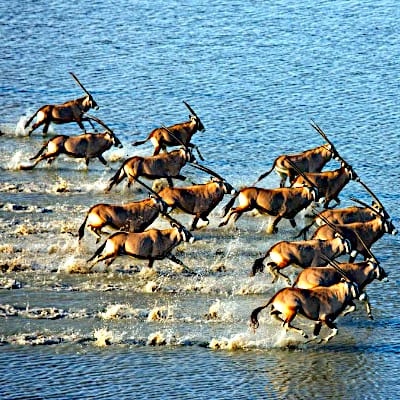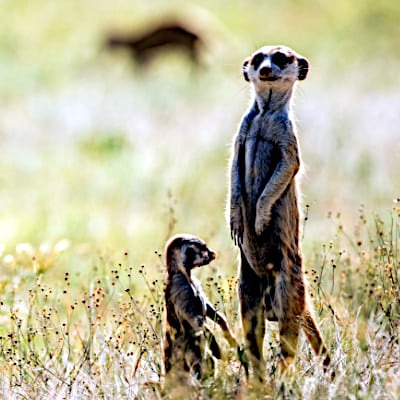FIND SERENITY IN THE SOUTH
A South African traveler once had this to say about the country of Namibia after a safari there: “One day, when you approach heaven, the entrance will look like Namibia.” A stark environment, yes, but exquisite in its vastness. It’s as if nature defines itself here. In Namibia, a desert is not just a sandy affair. Namibia has the world’s oldest living desert. The country seems to be chiseled by a strong force of nature. While it’s a harsh environment, it is totally worth going there, for it is untamed, majestic, and home to the world’s oldest and most surreal-looking plant, the Welwitschia mirabilis. But, more on this old-timer later. Namibia desert has a stronger sense of vast open space and remoteness you won’t find easily elsewhere. So, let’s head south! Here at TAG Safari HQ, we’re still chuckling about the time that the POTUS named Sarah Palin the ambassador to “Nambia” rather than to Namibia. The locals had a field day with this accidental slip and ranks it alongside “Africa is a country.” All in good humor, though. That’s what you’ll experience en route in Namibia – a mix of people with the friendliest of dispositions and a sense of humor to boot. NON-STOP SUNSHINE ALL YEAR LONG Subtropical desert climate? Tick. The northwest of the country can get wet – usually during the rainy season, which is from October to April (which is incidentally also the hottest time of the year). Summer temperatures can tread into the ‘unbearable’ range, going up into the 40⁰Cs (100⁰Fs), so if you can’t handle the heat, head for Namibia during the more temperate winter months. (NOTE: What are the winter months?) When you head south, you’ll find the weather to be hot and dry. Pack warm clothes for when the sun goes down though; the temperatures differ dramatically between night and day. The weather is generally clear, crisp and dry, (an average of 25⁰C/77⁰F) but if your safari takes you to the desert, expect the temperature to nosedive like a broken lift in an action movie. It can get freeeeeeezing at night. While we’re on the topic of weather, you’re in for a variety of temperatures at the Skeleton Coast (so-called due to the multitude of shipwrecks scattered along the shore), because of the icy Atlantic and its sidekick, the freezing Benguela current. The nights will be damp and cool, and expect to be mesmerized by a thick and dense fog when you drink your morning coffee. IS THAT A MIRAGE OR A STRANDED SHIP I SEE IN THE DESERT OF ALL PLACES? Flanked by the vast Namib Desert, the coastal town of Swakopmund instills a strong awareness of the senses. The area has a cinematic look and feel – gray gravel plains, rugged wilderness, deserts and dunes, huge walls of sand and granite, wild seas and an industrious town that almost clings to the sea or land – depending on which direction you view it from. A truly bizarre sight is that of the wreckage of a German ship, the Eduard Bohlen, that ran aground years ago from Swakopmund. (NOTE: Do you mean in Swakopmund?) Thick fog caused it to flounder, and overtime, the ship that was once stranded in the ocean slowly became stranded in the desert. It makes for remarkable one-of-a-kind photography, which brings us to the Namib’s famed sand dunes. There is a multitude of ‘adventure activities’ in and around Swakopmund for those who like a bit of an adrenaline rush. Think quad biking, sand boarding and sky diving, to name but three. Get in touch with an experienced guide at your lodge to attempt climbing ‘Dune 7’ or ‘Big Daddy’ as it’s affectionately and ‘out-of-breath-takingly’ known. Tall as a seven-story building it clocks a height of 388 m (1,273 ft). PARK LIFE Vast Namib-Naukluft Park is situated along the southern section of Namibia’s coastline – stretching 400 km (250 mi) from Walvis Bay to Lüderitz. Yup, it’s a 10th of the country’s surface area. Here, you can enjoy adrenaline-pumping activities, too, or go at a more tempered pace: horseback or camel rides through riverbeds and up into moonlight landscapes are on offer. In the northern part of the park, there are plenty of bucks, spotted hyenas, black-backed jackals, and lappet-faced vultures. Here you’ll find more than 50 species of mammals: leopards, caracals, aardwolves, and klipspringers. Plus, there are a recorded 200 species of birds ranging from Boubou Shrike to buzzards and falcons. Then there is the baffling Welwitschia mirabilis, with its long and wide leathery leaves. (See? I told you I’d get back to this.) They can live to be 2,000 years old. The plant is basically two permanent leaves that lie on the ground, taking a beating from the elements, year in and year out but growing ever longer. Another, more classic bit of flora is the seemingly withered desert lichen. Pour a tiny drop of water on it, and it will rise like a phoenix out of the ashes! The country ticks all three boxes for the right environment for sand dunes: a plethora of loose sand, wild winds and flat environments void of trees and mountains for the dunes to form. Namibia has them in droves. They rise in spectacular fashion to a height of 1,000 m (3,281 ft) above the surrounding plains. While you’re there, spot the beautiful Gemsbok (Oryx) here; the mammal believed to be behind the unicorn myth. PASS THE SALT The area of Sossusvlei sits within the Namib-Naukluft National Park in the southern corner of Namibia. When you stand within Sossusvlei, all you can see is a spectrum of red, pink and orange sand dunes with the whitest of white salt pans. It will bring out the intrepid explorer in you – from dusk until dawn. Traverse heady dunes, explore mysterious canyons. Just put your walking boots on or clamor inside a 4X4. The landscape is expansive with its technicolor hues and ever-shifting shapes. It should be no surprise that Sossuvlei is one of the most popular tourist attractions in Namibia, as while you’re there you can experience a serene type of isolation that can be felt nowhere else in the world. Imagine a photo taken of you as the sun rises over Africa surrounded by color-changing scenery, up atop a 325 m (1 066 ft) sand dune… it is a wonderful way to rediscover your place in this world. WELCOME TO “THE GREAT WHITE PLACE” If you opt for a safari in the Etosha National Park, the best season to go is winter – we’re looking at the lengthy stretch of May until September to plan your safari. Don’t even both putting your camera away, because you’re going to need it in a few seconds! The ‘Big Five’ are all present at this park. Etosha is a special place, as its drawcard is not only the fact that 114 different species of animals make this their home, but that you can see them all so easily. There are natural springs situated all along the edges of the pan, known as the ‘Place of Mirages.’ Eons ago it was a deep inland lake – hence its appearance as a vast, flat depression. The animals are drawn in droves to the numerous watering holes that still linger there. CAN YOU CONQUER THE CANYON? In terms of size, the Fish River Canyon takes silver for the largest canyon worldwide after the Grand Canyon in the USA. It forms part of the awe-inspiring Ai-Ais Richtersveld Transfrontier Park. If you want to have a summer safari in this region, stop the bus! During Namibia’s summer months the canyon hike is closed due to the intense heat. Good news though, you can traverse the Fish River Hiking Trail during the months of April until September. The full trail can be done in the space of 4 to 5 days, depending on your level of fitness. It covers a length of 85 km (38 mi), and as for the descent into the canyon, only hikers are allowed! So, put on your hiking shoes and expect to be blown away. A TOWN DEVOURED BY THE DESERT It is believed that in the early 1900s a railway worker found a sparkling diamond lying on top of the sand, then another, then a whole cluster more! So of course, it didn’t take long for glazy-eyed prospectors to flood the port of Lüderitz with a group of Germans at the helm. Kolmanskop became a thriving diamond town with a notorious reputation for drink, high jinx and payment, in diamonds, at the end of a wild night. However, like most things, the diamond harvest eventually showed a decline in diamonds found. Soon, the sand-clearing squad was nowhere to be seen and the desert took residence – inside the houses, the saloon, the church, the pharmacy, the shops, the school, an elegant ballroom, theater, casino, hospital, gymnasium, power station, school, skittle-alley, ice factory (!) and the railway station. For some time, this eerie town has been derelict and slowly disappearing under the sand. It’s even rumored to be haunted… how wonderful! NAMIBIAN SAFARI: A DESERT WONDERLAND All in all, Namibia has a ridiculous number of national parks – more than 20 – and about 200 privately-owned game reserves on top of those, all doing their utmost to protect its abundant animal life. Investigate the Sperrgebiet National Park, Ai-Ais and the Fish River Canyon Park – and remember that Etosha is the place to see the ‘Big Five.’ If your soul needs to breathe, then a safari in Namibia is the antidote. It’s an epic country with a landscape that offers an assortment of changing moods. You’ll feel in sync.
















Comments (1)
Muchas gracias. ?Como puedo iniciar sesion?